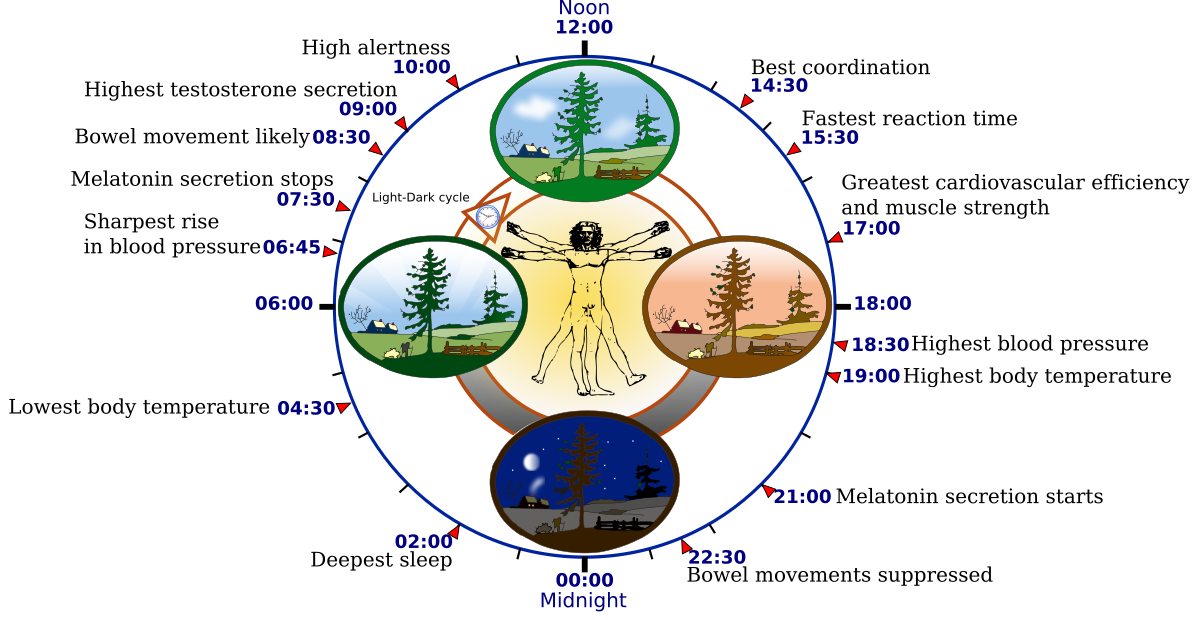In “Understanding the Circadian Rhythm: A Comprehensive Overview,” you’ll gain a deeper understanding of the fascinating world of circadian rhythms. This article takes a comprehensive look at the various factors that influence our internal body clock and how it impacts our daily lives. From the science behind circadian rhythms to the importance of maintaining a consistent sleep-wake schedule, this overview will shed light on this vital aspect of our biology. So, grab a cup of coffee and join us on this journey to unravel the secrets of the circadian rhythm.
What is Circadian Rhythm?
Definition
Circadian rhythm refers to the natural, internal process that regulates the sleep-wake cycle and various physiological functions within a 24-hour timeframe. It acts as an internal clock, helping our bodies align with the external environment and maintain balance. The term “circadian” is derived from the Latin words “circa” meaning “around” and “diem” meaning “day,” highlighting the rhythmic nature of this phenomenon.
Importance of Circadian Rhythm
Circadian rhythm plays a crucial role in numerous bodily processes and functions. It helps regulate our sleep patterns, hormone release, body temperature, and even our mood. By synchronizing our internal clock with the external environment, circadian rhythm allows us to optimize our physical and mental well-being. Understanding and maintaining a healthy circadian rhythm is essential for overall health and vitality.
Biological Basis of Circadian Rhythm
Suprachiasmatic Nucleus (SCN)
The suprachiasmatic nucleus (SCN) is often referred to as the “master clock” of the body. Located in the hypothalamus, it is responsible for generating and maintaining the circadian rhythm. The SCN receives signals from the retina, which help set our internal clock based on the light-dark cycle. Through neural and hormonal signaling, the SCN regulates various bodily functions and ensures their alignment with the 24-hour day.
Melatonin Secretion
Melatonin, often known as the sleep hormone, plays a vital role in regulating our sleep-wake cycle. It is produced and released by the pineal gland in response to darkness and signals the body that it’s time to sleep. Melatonin levels rise in the evening, peak during the night, and gradually decrease in the morning. This secretion pattern is crucial in promoting healthy sleep and wakefulness.
Body Temperature Regulation
Circadian rhythm also influences body temperature regulation. Our core body temperature follows a diurnal pattern, with a decrease during the evening and a rise in the morning. These fluctuations align with our sleep-wake cycle, helping promote alertness during the day and triggering sleepiness at night. Temperature regulation is closely linked to our circadian rhythm and plays a significant role in maintaining optimal physiological functioning.
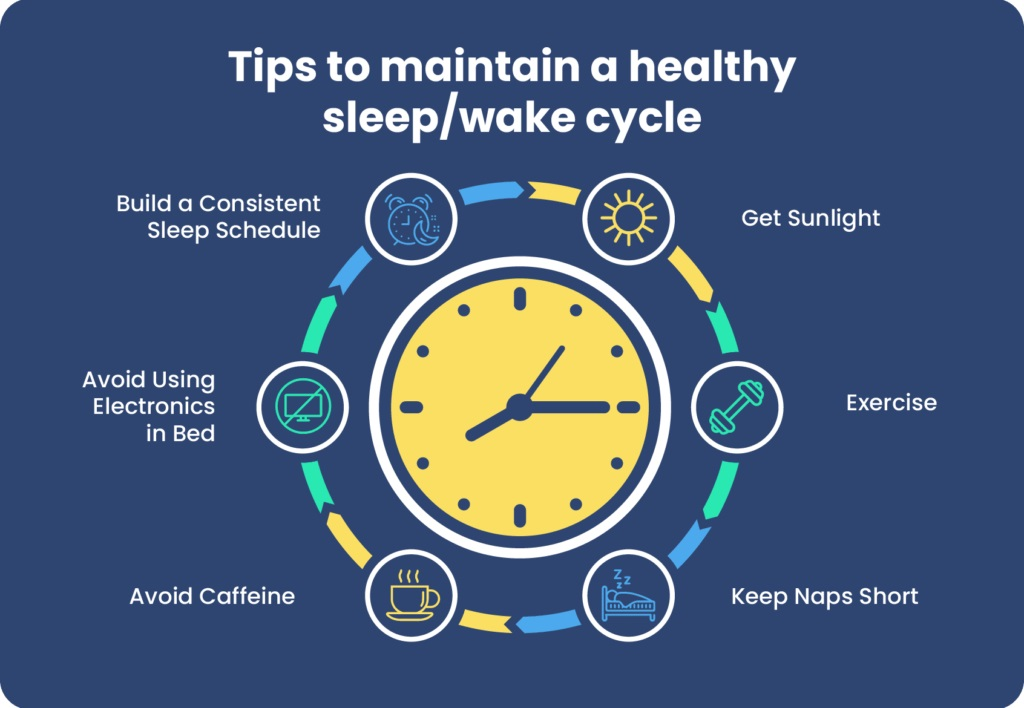
This image is property of www.sleepfoundation.org.
Sleep-Wake Cycle
Stages of Sleep
The sleep-wake cycle consists of several stages that alternate throughout the night. These stages include non-rapid eye movement (NREM) sleep and rapid eye movement (REM) sleep. NREM sleep is further divided into three stages: N1, N2, and N3. N1 is the transition from wakefulness to sleep, while N2 represents light sleep. N3, also known as slow-wave or deep sleep, is the most restorative stage. REM sleep, characterized by rapid eye movements and vivid dreams, occurs cyclically throughout the night.
Role of Circadian Rhythm in Sleep Regulation
Circadian rhythm plays a crucial role in regulating the timing and quality of our sleep. It helps determine when we feel most alert during the day and when our natural propensity for sleep increases. The body’s internal clock synchronizes with external cues, such as daylight and darkness, to promote wakefulness during the day and restful sleep at night. Disturbances in the circadian rhythm can disrupt the sleep-wake cycle, leading to sleep disorders and fatigue.
The 24-hour Body Clock
Synchronization with the External Environment
Our circadian rhythm is closely tied to the external environment, particularly the light-dark cycle. Exposure to natural light during the day helps regulate our internal clock, promoting wakefulness and alertness. Conversely, the absence of light at night triggers the release of melatonin, signaling the body to prepare for sleep. Maintaining a consistent sleep-wake schedule and aligning our activities with the natural rhythms of the day can optimize our circadian rhythm.
Internal Factors Influencing Circadian Rhythm
In addition to external cues, internal factors also influence circadian rhythm. Genetics, age, and individual variations can affect how our internal clock functions. Some individuals may be “morning people” or “night owls” due to variations in their circadian rhythm. Hormonal fluctuations, such as those occurring during puberty or menopause, can also impact the timing and quality of sleep. Understanding these internal factors can help tailor strategies to optimize circadian rhythm.
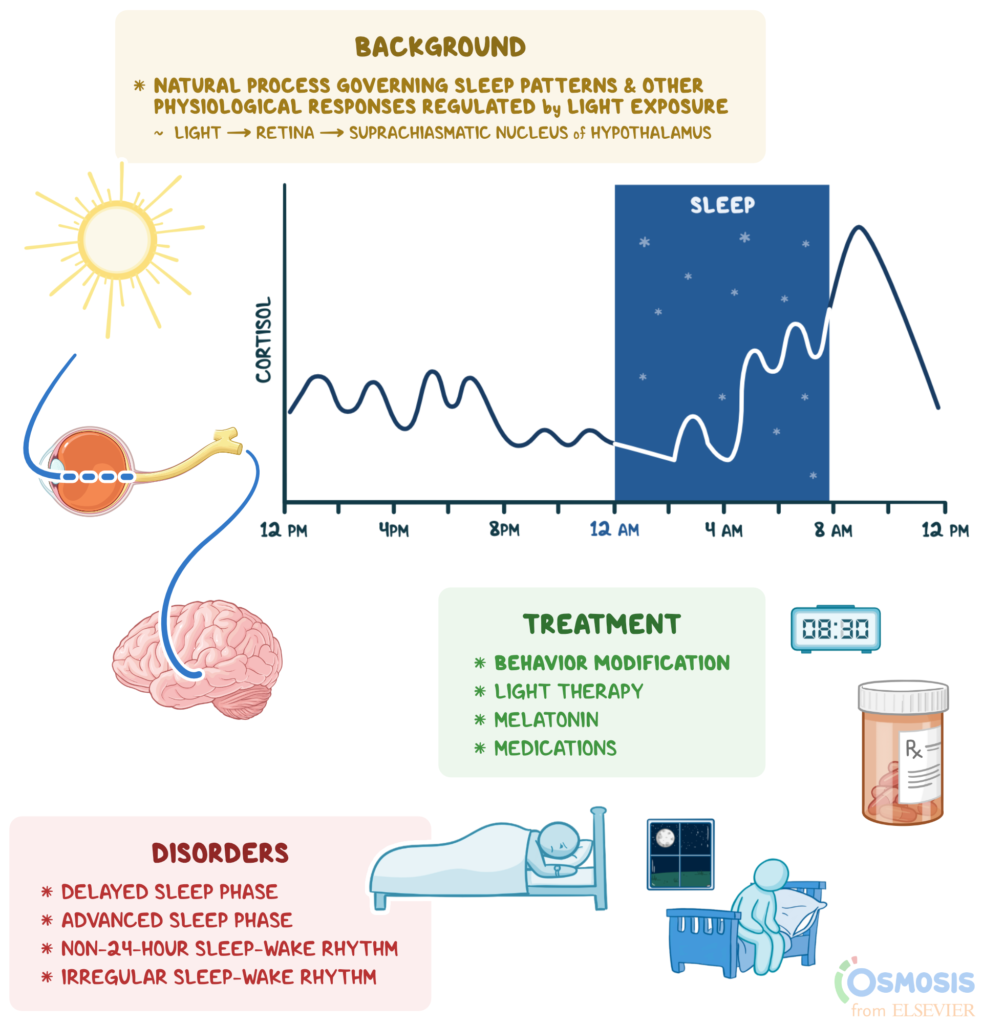
This image is property of d16qt3wv6xm098.cloudfront.net.
Circadian Rhythm Disorders
Delayed Sleep Phase Syndrome (DSPS)
Delayed Sleep Phase Syndrome (DSPS) is a circadian rhythm disorder characterized by a delayed sleep-wake pattern. Individuals with DSPS have difficulty falling asleep and waking up at conventional times, often experiencing a shift to a later sleep schedule. This can significantly impact daily functioning, as individuals with DSPS may struggle to align their sleep-wake schedule with societal norms.
Advanced Sleep Phase Syndrome (ASPS)
On the opposite end of the spectrum, Advanced Sleep Phase Syndrome (ASPS) is a circadian rhythm disorder where individuals experience an advanced sleep-wake pattern. People with ASPS tend to fall asleep and wake up much earlier than the average person, often feeling sleepy in the early evening. This can pose challenges in social and professional contexts, as it may be difficult to maintain a typical daily schedule.
Shift Work Disorder (SWD)
Shift Work Disorder (SWD) occurs when individuals work non-traditional hours, such as overnight shifts or rotating schedules, disrupting their natural circadian rhythm. This can lead to difficulties sleeping during the day and staying awake at night, resulting in sleep deprivation and impaired performance. Managing shift work and minimizing its impact on circadian rhythm requires special attention to sleep hygiene and scheduling strategies.
Jet Lag Syndrome
Jet Lag Syndrome is a temporary disruption of the circadian rhythm that occurs when traveling across multiple time zones. The rapid change in time zones can cause symptoms such as fatigue, insomnia, difficulty concentrating, and gastrointestinal distress. Adjusting sleep patterns and gradually acclimating to the new time zone can help minimize the effects of jet lag and restore circadian rhythm.
Impacts of Disrupted Circadian Rhythm
Cognitive Impairment
Disrupted circadian rhythm can have a significant impact on cognitive function. Sleep deprivation and irregular sleep patterns can impair attention, memory, and decision-making abilities. Chronic sleep disturbances can also contribute to long-term cognitive decline and increase the risk of developing neurodegenerative diseases, such as Alzheimer’s disease.
Mood Disorders
Circadian rhythm disruptions have been linked to mood disorders, such as depression and bipolar disorder. Irregular sleep patterns and disturbances in melatonin secretion can disrupt the delicate balance of neurotransmitters involved in mood regulation. Optimizing circadian rhythm through proper sleep habits and light exposure can help alleviate symptoms and improve overall mood.
Metabolic Disorders
Disruptions in circadian rhythm have been associated with an increased risk of metabolic disorders, including obesity, diabetes, and cardiovascular diseases. Irregular sleep patterns and altered meal timing can disrupt the body’s metabolic processes, leading to imbalances in hormones involved in appetite regulation and metabolism. Maintaining a healthy circadian rhythm through consistent sleep and meal schedules can contribute to metabolic health.
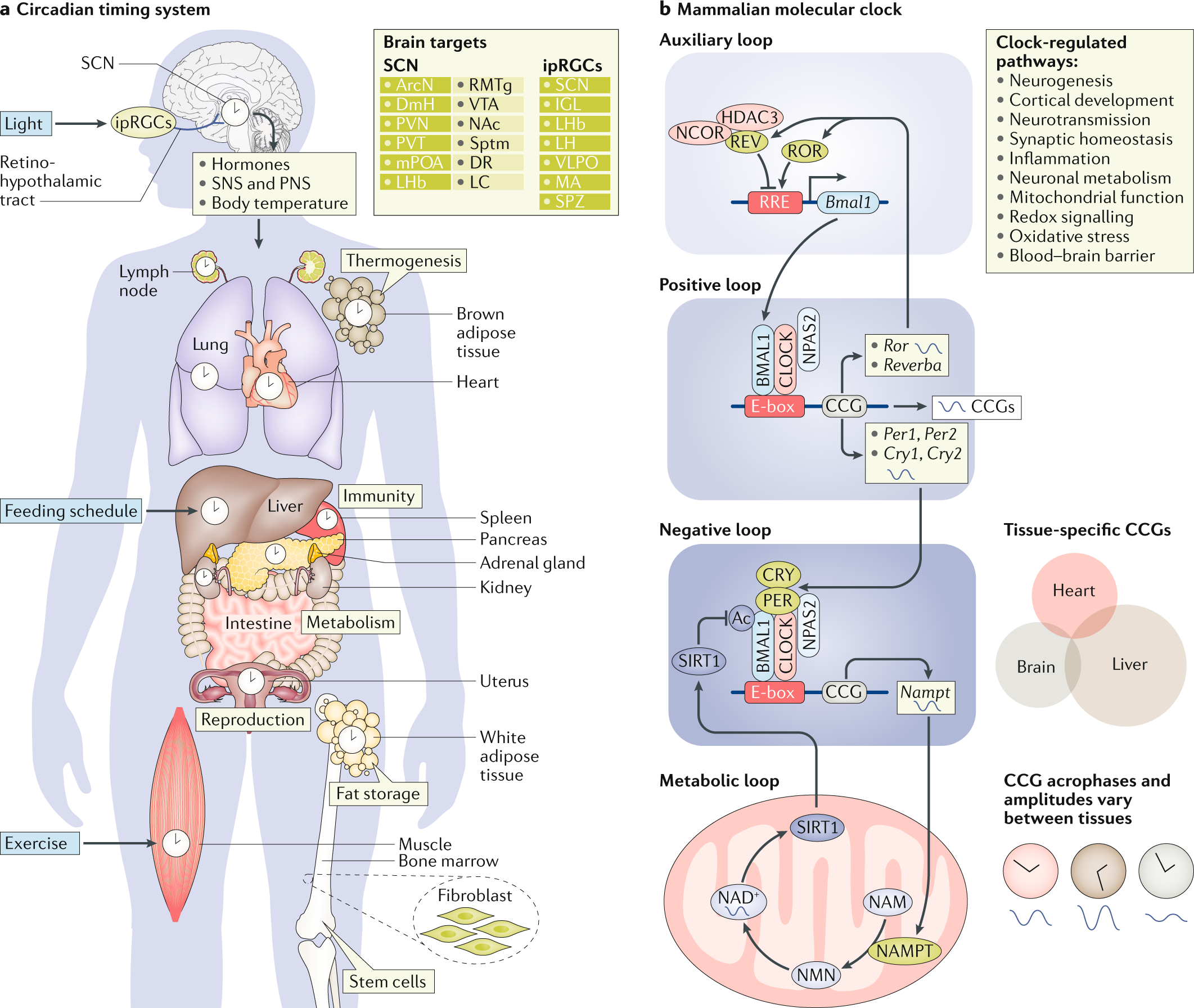
This image is property of media.springernature.com.
Factors Affecting Circadian Rhythm
Light Exposure
Exposure to natural light during the day helps regulate our circadian rhythm. Bright light, particularly in the morning, can signal wakefulness and align our internal clock with the external environment. On the other hand, exposure to bright artificial light, particularly blue light emitted by electronic devices, close to bedtime can suppress melatonin secretion and disrupt sleep. Managing light exposure, particularly in the evening, can help optimize circadian rhythm.
Meal Timing
Meal timing can also influence circadian rhythm. Irregular eating patterns or late-night eating can disrupt the body’s natural fasting and feeding cycles. This can impact the release of hormones involved in metabolism and sleep regulation. Establishing consistent meal schedules and avoiding heavy meals close to bedtime can support a healthy circadian rhythm.
Physical Activity
Regular physical activity can help regulate circadian rhythm. Engaging in exercise during the day promotes alertness and wakefulness, while avoiding vigorous exercise close to bedtime allows the body to wind down for sleep. Regular exercise has been shown to enhance the quality of sleep and promote a healthy circadian rhythm.
Ways to Optimize Circadian Rhythm
Maintaining a Consistent Sleep Schedule
Establishing a regular sleep-wake schedule is essential for maintaining a healthy circadian rhythm. Going to bed and waking up at consistent times, even on weekends, can help synchronize the internal clock and promote better sleep quality. Creating a relaxing bedtime routine and ensuring a comfortable sleep environment can also support optimal circadian rhythm.
Creating Ideal Sleep Environment
Creating a sleep-friendly environment can contribute to a healthy circadian rhythm. This includes ensuring a cool, dark, and quiet bedroom. Using blackout curtains or eye masks to block out external light, reducing noise disturbances, and optimizing bedding and pillows for comfort can all contribute to better sleep quality and regulation of the sleep-wake cycle.
Limiting Exposure to Blue Light
Blue light emitted by electronic devices can interfere with our circadian rhythm. It suppresses the release of melatonin, making it harder to fall asleep and disrupting the sleep-wake cycle. Limiting screen time, especially before bed, using blue-light filters on devices, and avoiding electronic use in the bedroom can help minimize the impact of blue light on circadian rhythm.
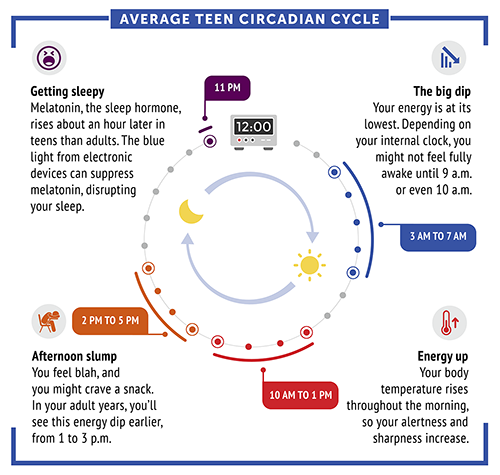
This image is property of nigms.nih.gov.
Effects of Aging on Circadian Rhythm
Changes in Sleep Patterns
As we age, our circadian rhythm undergoes changes. Older adults tend to experience a shift in their sleep-wake cycle, often feeling sleepy earlier in the evening and waking up earlier in the morning. This can result in difficulties maintaining a typical daily schedule and may require adjustments to sleep habits and routines. Understanding these changes can help older adults adapt and optimize their circadian rhythm.
Impact on Overall Health
Disruptions in circadian rhythm, particularly in older adults, can have implications for overall health. Sleep disturbances and irregular sleep patterns can contribute to an increased risk of chronic diseases, cognitive decline, and compromised immune function. Optimizing circadian rhythm through healthy sleep practices and lifestyle choices is crucial for maintaining optimal health as we age.
Circadian Rhythm and Modern Lifestyle
Night Shift Work
Night shift work poses significant challenges to circadian rhythm. Working during the night and sleeping during the day disrupts the body’s natural sleep-wake cycle and can lead to sleep disturbances, fatigue, and increased health risks. Managing the impact of night shifts on circadian rhythm requires strategies such as maintaining consistent sleep schedules, optimizing the sleep environment, and implementing healthy lifestyle practices.
Electronic Devices and Circadian Rhythm
The use of electronic devices has become deeply ingrained in modern life, but it can disrupt our circadian rhythm. The blue light emitted by smartphones, tablets, and computers can disrupt melatonin secretion and interfere with sleep quality. Establishing “screen-free” periods before bed, using blue-light filters or night mode on devices, and keeping electronic devices out of the bedroom can help mitigate the effects of electronic device use on circadian rhythm.
In conclusion, understanding and optimizing our circadian rhythm is vital for our overall well-being. From regulating sleep patterns to influencing hormone secretion and metabolic processes, circadian rhythm plays a crucial role in our physiological and psychological functioning. By respecting the natural rhythms of our bodies, establishing healthy sleep habits, and managing external factors that can disrupt our internal clock, we can support a healthy circadian rhythm and promote optimal health and vitality.
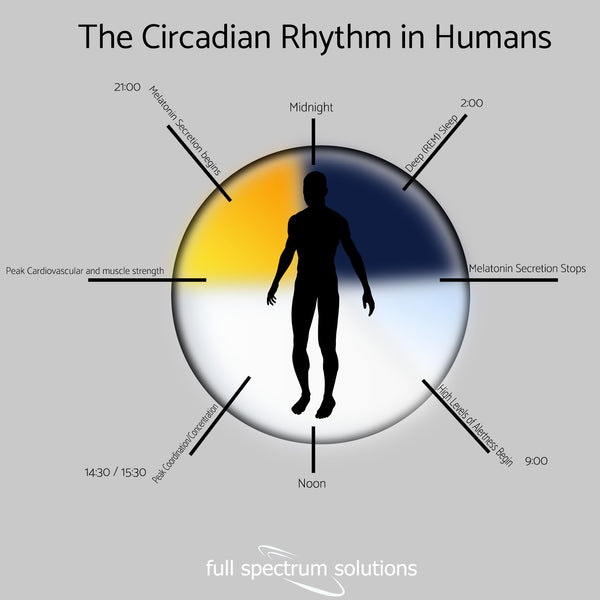
This image is property of cdn.shopify.com.

